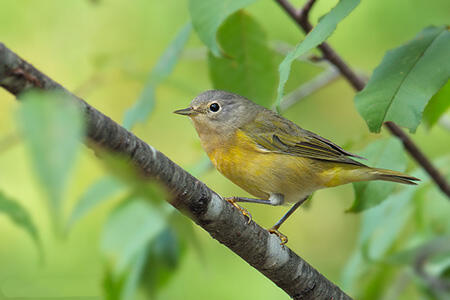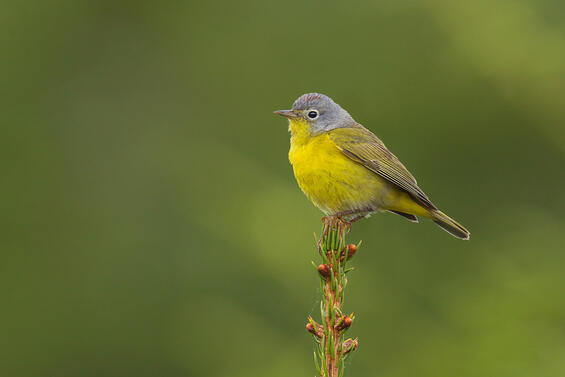- Scientific name: Vermivora ruficapilla
Species of Greatest Conservation Need (MA State Wildlife Action Plan)
Description

Nashville warbler (Vermivora ruficapilla)
The Nashville warbler is a medium-sized wood warbler with yellow underparts, green back, and a gray head with a rufous crown patch and bold eye ring. In contrast to many species of warblers, Nashville warblers lack wing bars and any white markings on the tail. Males and females are similar, but females tend to be drabber with a less extensive (and often obscured) rufous patch on their head. Hatching-year fall females can be very dull and can be confused with Tennessee and orange-crowned warblers.
Life cycle and behavior
Nashville warblers typically arrive in Massachusetts during late April, with spring migration continuing throughout May. During this period, they can be observed in various habitats, including parks, orchards, and woodland edges. Nashville warblers breed in the northern and western United States and parts of southern Canada. They construct open cup nests on the ground, typically concealed under shrubs or in mossy areas. Females lay 4 to 5 eggs per clutch, incubating them for 11 to 12 days. Both parents participate in feeding the hatchlings, which fledge approximately 11 days after hatching. These warblers primarily consume insects, foraging by gleaning in the lower parts of trees and shrubs and frequently flicking their tails.

Population status
Overall populations of the Nashville warbler are considered relatively stable. Their nests are seldom parasitized by cowbirds, contributing to their stable numbers. In Massachusetts the Nashville warbler was essentially unknown as a breeding bird before 1830, but rapidly increased and became relatively common by the mid-1800s. Their numbers in the state peaked in the early 1900s and are thought to have steadily declined ever since. As indicated in the Breeding Bird Survey, the Nashville warbler has experienced a sharp annual decline since 1966 in Massachusetts (-4.2%) and similar declines are documented in the mid-Atlantic/New England region. This decline is largely the result of a reduction in their breeding habitat, as young forests have declined in Massachusetts and many areas throughout the region.
Distribution and abundance
The Nashville warbler is broken into two disjunct populations: one in the West and another in the East. The western population includes the south inland portion of British Columbia through the Cascade Mountains of Washington and Oregon and into the Sierra Nevada Mountains of northern California. The eastern population extends from the boreal forest of central and eastern Canada to the Great Lakes region and throughout the northeastern United States. Their wintering range includes Mexico and Central America.
Habitat
The Nashville warbler prefers regenerating areas of boreal, mixed hardwood-pine, and hardwood forests characterized by shrubby undergrowth. This habitat is created both through natural processes (e.g., fire, storms) and by anthropogenic activities (e.g., forest harvesting). Due to a reduction in the amount of habitat created from natural events, forestry practices may be required to maintain historical levels of young forest in the state. Nest sites are often located along the edges of forests, fields, ponds, or located along a stream. Nests are well-concealed and placed on the ground under shrubs or within patches of grass.
Healthy habitats are vital for supporting native wildlife and plants. Explore habitats and learn about conservation and restoration in Massachusetts.

Nashville warbler (Vermivora ruficapilla)
Threats
Although this is a relatively little-studied species, the primary threat to the Nashville warbler is thought to be loss and degradation of its breeding habitat. As with other nocturnal migrants, this species is also vulnerable to collisions with man-made structures. Predation by domestic cats is also a factor, particularly in the nesting season.
Predation by domestic cats has been identified as the largest source of mortality for wild birds in the United States with the number of estimated mortalities exceeding 2 billion annually. Cats are especially a threat to those species that nest on or near the ground.
An additional threat to the species is collisions with buildings and other structures, as approximately 1 billion birds in the United States are estimated to die annually from building collisions. A high percentage of these collisions occur during the migratory periods when birds fly long distances between their wintering and breeding grounds. Light pollution exacerbates this threat for nocturnal migrants as it can disrupt their navigational capabilities and lure them into urban areas, increasing the risk of collisions or exhaustion from circling lit structures or areas.
Conservation
Management for the Nashville warbler should focus on maintaining and restoring young forest and successional forest habitats, particularly areas with dense shrubby undergrowth that provide suitable breeding conditions. A combination of management techniques, including selective timber harvesting, mechanical thinning, and prescribed burns, can be used to create and sustain the young forest conditions this species depends on. In regions dominated by mature forests, incorporating early successional habitat patches within rotational forest management plans will help maintain a mosaic of habitat types. Additionally, managing utility rights-of-way and abandoned fields to preserve shrubland characteristics can provide critical nesting and foraging opportunities. Where existing habitat remains intact, conservation efforts should prioritize protecting these areas from urbanization and land conversion to ensure stable breeding populations of the Nashville warbler.
Promote responsible pet ownership that supports wildlife and pet health by keeping cats indoors and encouraging others to follow guidelines found at fishwildlife.org.
Bird collision mortalities can be minimized by making glass more visible to birds. This includes using bird-safe glass in new construction and retrofitting existing glass (e.g., screens, window decals) to make it bird-friendly and reducing artificial lighting around buildings (e.g., Lights Out Programs, utilizing down shielding lights) that attract birds during their nocturnal migration.
References
Dunn, Jon L., and Kimball L. Garrett. Warblers of North America. Boston: Houghton Mifflin Harcourt, 1997.
Cornell Lab of Ornithology. “Nashville Warbler Overview.” 2024. All About Birds.
National Audubon Society. “Nashville Warbler.” 2024. Audubon Field Guide.
Mass Audubon. “Nashville Warbler.” 2024. Breeding Bird Atlas.
Animal Diversity Web. “Leiothlypis ruficapilla (Nashville Warbler).” 2024. University of Michigan Museum of Zoology.
King, D. I., and R. M. DeGraaf. “Habitat Management for Breeding Birds in Early-Successional Habitats.” Wildlife Society Bulletin 28, no. 3 (2000): 734-740.
Rodewald, A. D., and M. C. Brittingham. “Habitat Use and Behavior of Mixed Species Landbird Flocks during Fall Migration.” The Wilson Bulletin 111, no. 4 (1999): 599-610.
Sauer, J.R., J.E. Hines, J.E. Fallon, K.L. Pardieck, D.J. Ziolkowski, Jr., and W.A. Link. 2022. The North American Breeding Bird Survey, Results and Analysis 1966 - 2022. Version 01.30.2015 USGS Patuxent Wildlife Research Center, Laurel, MD.
Contact
| Date published: | May 15, 2025 |
|---|